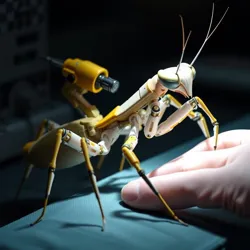Precision Mantis Units

Precision Mantis Units (PMUs) are highly specialized biomechanical arthropods developed for ultra-precise manipulation and surgical applications. Created as an offshoot of the Mantis Class Combat Units program, PMUs represent a significant advancement in micro-surgical robotics and precision engineering.
Technical Specifications
PMUs feature a sophisticated array of quantum-stabilized limbs controlled by advanced neural networks. Their primary manipulators contain over 1,000 individually articulated micro-joints, allowing for movement precision down to 0.1 microns. The units are powered by specialized micro-fusion cores that provide stable, continuous operation for up to 96 hours.
Key Features
- Quantum-stabilized manipulation system
- Neural-haptic feedback interface
- Self-repairing nano-chitin coating
- Integrated sterility field generator
- Advanced optical arrays with 1000x magnification
Applications
Medical Procedures
PMUs excel in microsurgical operations, particularly in: - Neural pathway repair - Cellular reconstruction - Quantum-organic implant installation - Microscale tissue engineering
Industrial Use
These units have found applications in: - Quantum circuit assembly - Molecular manufacturing - Precision calibration of synthetic arthropod components - Nanoscale material manipulation
Development History
Originally conceived by the Arthropod Dynamics Lab in 2165, PMUs went through extensive refinement before their first successful deployment in medical facilities. The breakthrough came with the integration of quantum stabilization technology, which eliminated microscale tremors that had previously limited precision.
Current Models
- PMU-Alpha: Standard medical model
- PMU-Beta: Industrial precision unit
- PMU-Gamma: Research and development variant
- PMU-Delta: Combat medicine specialist
Future Development
Research continues into enhancing PMU capabilities through integration with quantum computing cores and advanced materials. Recent experiments with crystalline neural networks show promise for even greater precision and control.
See Also
- Biomechanical Surgery Systems
- Quantum Manipulation Technology
- Synthetic Medical Units
References
- Journal of Synthetic Medicine
- Precision Robotics Quarterly
- Biomechanical Engineering Review